According to many ancient traditions, divine wrath is often expressed through fire and brimstone. Brimstone, it turns out, is an archaic name for the element sulfur and became a symbol of punishment because of the sulfuric aroma that accompanies lightning strikes.
If you’re not a fan of broccoli, you may have grown up associating the vegetable with a different form of punishment — the one that transpired when you didn’t eat everything on your plate. If you have kids, you might have experienced the other end of that deal, trying to get your picky eaters to eat broccoli, either through cajoling and bribes, or by hiding it in sauces thanks to a blender or food processor. Of course, there are also a few of us who adore the taste and aroma of broccoli.
But what’s the connection between broccoli and brimstone? It all comes down to the element that people either love or hate in the vegetable. In a word, sulfur.
The potent aroma in broccoli comes from a super healthy, powerful antioxidant called sulforaphane. And once you learn just why sulforaphane is so good for you, you may decide that eating broccoli and broccoli sprouts are worth putting up with the smell of sulfur. Because unlike brimstone, broccoli confers rewards, not punishments, especially in the realm of your health.
So what’s so special about sulforaphane, and especially, broccoli sprouts? And why should you be including them in your diet?
What is Sulforaphane?
Sulforaphane is a phytonutrient, which is a fancy word for “nutrient found in a plant.” It functions as a powerful antioxidant, meaning it fights against and repairs the damage that occurs all the time in every cell in your body. It’s also an isothiocyanate — a type of compound that’s synthesized from a precursor found in cruciferous vegetables, which are a part of the Brassica family. If you have a decent chemistry lab, and you want to make it at home, the chemical formulation is C6H11NOS2.
When we say that broccoli or some other Brassica contains sulforaphane, that’s actually a slightly misleading statement. The vegetable technically contains the precursor, an isothiocyanate, that then converts to sulforaphane. But how does that work?
The isothiocyanate found in the sulforaphane-generating vegetables is called glucoraphanin, a biologically active, sulfur-containing glucosinolate compound that gives them that strong smell and taste. In nature, one of its main functions is to repel pests. The glucoraphanin remains stable until the plant is broken, such as by the cutting or chewing of an insect or animal. Once that happens, the glucoraphanin comes in contact with an enzyme called myrosinase, which is stored in another compartment of the cell. Spurred on by access to myrosinase, our gut bacteria then convert glucoraphanin to sulforaphane.
You can think about it a little like those heat packs that you have to shake to activate. Shaking, or in this case chewing, brings compounds together to create new and potent effects. Sulforaphane then goes to work keeping you healthy.
7 Health Benefits of Sulforaphane

So what exactly can sulforaphane do for you? Below are seven potential health benefits of sulforaphane with the most evidence behind them.
1. It may have anti-inflammatory properties.
Unchecked and chronic inflammation can increase your risk for a variety of unwanted health conditions and even chronic diseases. The World Health Organization estimates that 70% of all deaths globally can be attributed to chronic inflammatory conditions. That’s one reason why eating a largely anti-inflammatory diet can be so beneficial for overall health outcomes. Sulforaphane appears to inhibit inflammation in conditions like inflammatory bowel disease, gouty arthritis, type 1 and 2 diabetes, atherosclerosis, and some autoimmune disorders. It may also have a potential application in helping to treat some chronic inflammatory diseases, including rheumatoid arthritis, respiratory conditions, cardiovascular diseases, and cancer.
Think of broccoli as nature’s fire hose, dousing inflammation in your cells and giving your tissues a chance to cool down and recover.
2. It may boost liver function and help with natural detoxification.
In a 2019 study published in Experimental Hematology (a journal that sadly missed the chance to be called “Messing Around with Blood”), sulforaphane was found to help reduce liver damage among rats with sickle cell disease, playing a role in the detoxification of heme released from lysed (ruptured) red blood cells.
In another study, sulforaphane from a broccoli sprout extract protected the liver and induced detoxification by triggering enzymes and the creation of glutathione. Glutathione is an all-star antioxidant (wouldn’t that be a great name for a sports team: The Antioxidants?) composed of three amino acids: glutamine, glycine, and cysteine. It works by fighting against free radicals that can cause cell damage and cancer. Just about all of life’s stresses can deplete our glutathione reserves, which is hard for the body to access in supplement form. So it’s good news that we can get it from broccoli and broccoli sprouts!
Neutralizing Benzene
And in a 2019 study published in the American Journal of Clinical Nutrition, researchers looked at the detoxification effects of sulforaphane in humans related to the carcinogen benzene found in air pollutants. Benzene may sound exotic, but if you’ve ever smelled gasoline while filling your tank, or got a little clumsy filling a lawnmower or weed whacker, you have ingested a fair amount of the stuff. Even second-hand cigarette smoke and car exhaust will give you a dose of benzene that should make you run, not walk, to the nearest McBroccoli’s restaurant. (What? That doesn’t exist yet? I sense a great business opportunity!)
In the study, 170 participants were assigned randomly to either drink a placebo beverage or one of three graded concentrations of a broccoli sprout beverage for 10 consecutive days. Concentrations of SPMA, a biomarker that rises in urine as a result of enhanced detoxification, were measured. In the end, it was found that drinking the full-strength broccoli sprout beverage (but not the dilutions) boosted the detoxification of benzene.
3. It may protect your brain.
Sulforaphane may have protective effects on cognition and brain function, or as we say when we’re not pretending to be neurologists, it may keep you smarter longer. In a 2016 study published in the Journal of Neuroinflammation, after some very unfortunate rats were put into a state of hyperammonemia (characterized by high levels of ammonia in their blood), sulforaphane was found to reverse cognitive disruption. Sulforaphane may also have the potential to prevent neuronal disorders such as Alzheimer’s disease by enhancing the expression of brain-derived neurotrophic factor (BDNF). BDNF, also known as “brain fertilizer,” helps protect existing neurons and supports the growth and differentiation of new ones in the brain. And a 2018 study concluded that sulforaphane can be protective against brain diseases largely due to its antioxidant, anti-inflammatory, and anti-tumor properties.
4. It may have anticancer properties.
If you know someone who’s gone through chemotherapy to fight their cancer, you’ve seen how uncomfortable and taxing a process that can be. Imagine food that could mimic the positive effects of chemotherapy without the harmful and debilitating side effects.
Sulforaphane appears to have chemopreventive properties and the capacity to be selectively toxic to malignant cells. It seems to know which cells are naughty and nice (kind of like a smelly Santa Claus) and treats them accordingly. The effects are so potent that researchers suggest it may have clinical applications on its own as well as in combination with current therapeutic and management strategies for cancer. Additionally, sulforaphane may have cancer-preventing properties for specific types of cancer, particularly pancreatic and prostate, either on its own or used with other treatment approaches.
5. It may promote healthy weight loss and help prevent obesity.
Leptin is a hormone primarily made by cells in the small intestine and fat tissues, which help regulate hunger/fullness cues and manage fat storage. When your leptin levels are high, your brain gets the message that you’re full and should stop eating. It also gets informed that you have plenty of fat stored, so you don’t need to store anymore.
If you are leptin-resistant, though, your brain never gets that message, and you’re more likely to become obese because your body will not be able to register satiety. In a 2018 study published in the European Journal of Pharmacology, researchers found that treating high-fat, high-sucrose-fed obese mice with sulforaphane for 23 days induced a better response to leptin compared to those mice not treated with sulforaphane. Those who received it ate significantly less food overall and experienced significantly less weight gain. Another study found that the sulforaphane precursor glucoraphanin (a glucosinolate) could protect against obesity-related inflammation by enhancing energy expenditure and browning of white adipose tissue.
6. It may protect your heart from damage.
Doxorubicin is an antitumor drug used in chemotherapy. But its use is limited because it tends to damage the heart and can even lead to heart failure. In one animal study, an unfortunate group of male rats were given doxorubicin to induce heart damage. But when they were also given sulforaphane, it significantly protected them from that damage. Other research supports this finding, as studies have shown that sulforaphane protects against cardiovascular disease and related conditions, largely due to its antioxidant and anti-inflammatory properties.
7. It may have antimicrobial properties.
Sulforaphane appears to have antimicrobial properties that can protect against gut pathogens. This was demonstrated in a 2020 study, in which participants who consumed sulforaphane-enriched broccoli soup saw inhibited bacterial growth in their stomach and upper small intestine compared to the group who consumed broccoli soup that had not been enriched with additional sulforaphane.
In another study, researchers found that sulforaphane helped to eradicate H. pylori infections in the gut. In fact, the sulforaphane was able to kill the forms of H. pylori responsible for full-blown infections within just 24 hours. While more targeted human research is needed, there’s promise that sulforaphane could have clinical applications in antibacterial treatments. Given the rise of antibiotic-resistant “superbugs,” it’s great to know that nature provides us with foods that can help bacterial infections at bay.
Sulforaphane-Rich Foods
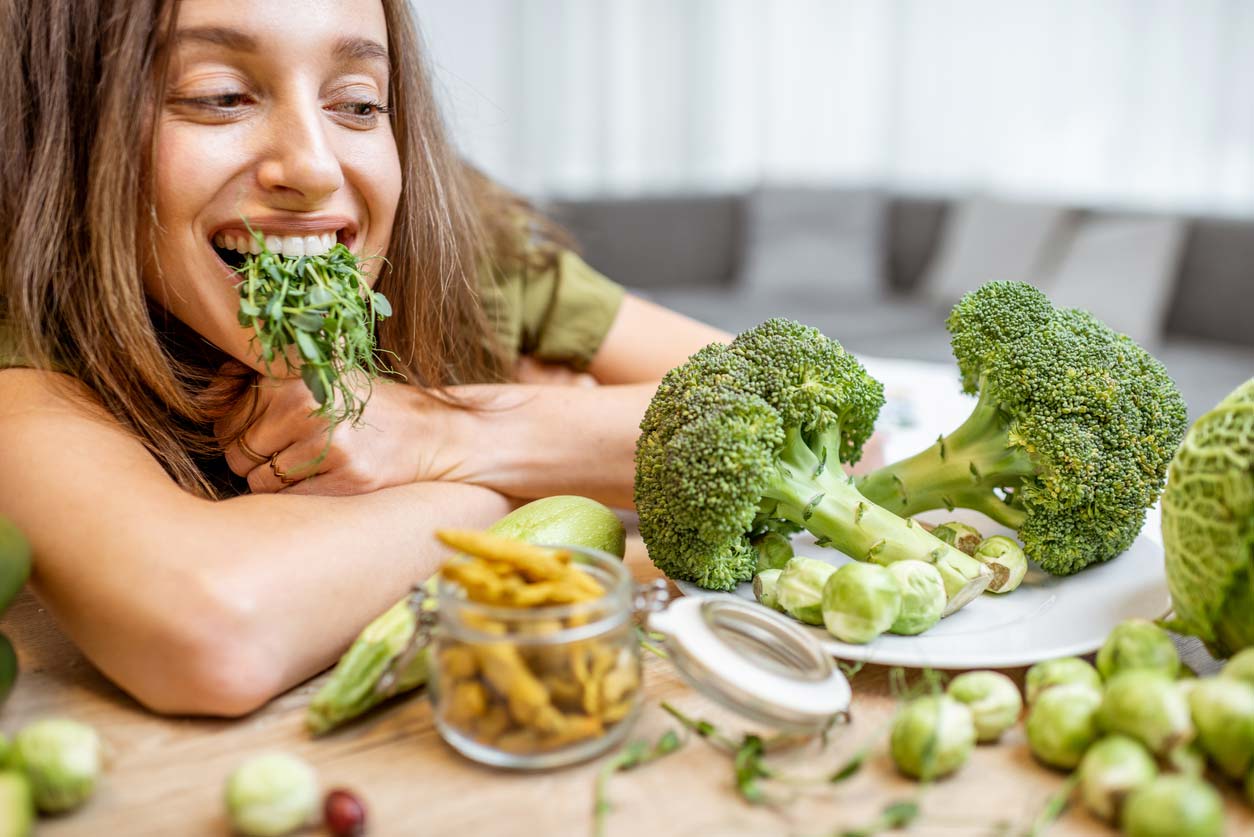
Sulforaphane is synthesized only from cruciferous vegetables. The highest amounts of glucosinolates — sulforaphane’s precursor — are found in raw, uncooked crucifers. Interestingly, domesticated varieties have less glucosinolates than wild-grown varieties. (For you music-loving gardeners out there: No, blasting “Born to be Wild” by Steppenwolf will not increase the glucosinolate levels of your plants.) Glucosinolates are most abundant in the flower buds and seeds of these veggies, and the levels vary between species.
Below are the glucosinolate levels of some popular cruciferous vegetables:

Broccoli Sprouts
If there was ever to be some sort of a glucosinolate Olympics, though, broccoli sprouts would win gold. They offer the highest amount of glucosinolate per serving out of all vegetables. A mere 1-ounce serving of broccoli sprouts provides 73 mg of glucosinolates (that’s 292 mg in ½ cup!). Because they’re so impressive, broccoli sprouts — and their extracts, in the forms of powders or supplements — have been the focus of much of the research on sulforaphane. When compared to regular broccoli, broccoli sprouts have 10-100 times the power of regular broccoli in terms of glucosinolate concentration per serving.
Are There Any Side Effects Related to Sulforaphane?
While you may be feeling inclined to add more sulforaphane-rich cruciferous veggies into your diet, you may also be wondering how much is too much.
Fortunately, there are little to no substantial side effects when eating foods rich in sulforaphane. However, while only really seen in animal studies, there is the possibility that very high amounts of sulforaphane may interfere with iodine absorption and have the potential to contribute to the development of hypothyroidism. But you would have to eat an enormous amount of cruciferous vegetables — many times over the recommended amount of roughly two cups daily — for this to be a real risk.
The most common unwanted effects of eating sulforaphane-rich cruciferous veggies are that they may cause gas and bloating in some people, due to their high fiber and organosulfur compound content. This is more likely to occur among people who are not used to eating other foods rich in these compounds. While not dangerous, it’s possible that even broccoli sprouts or their extract may cause unwanted gastrointestinal side effects, such as loose stools and excessive gas. As in all things, listen to your body. If you experience unwanted effects, scale back, and then slowly add your brassicas back in.
What About Sulforaphane Supplements?
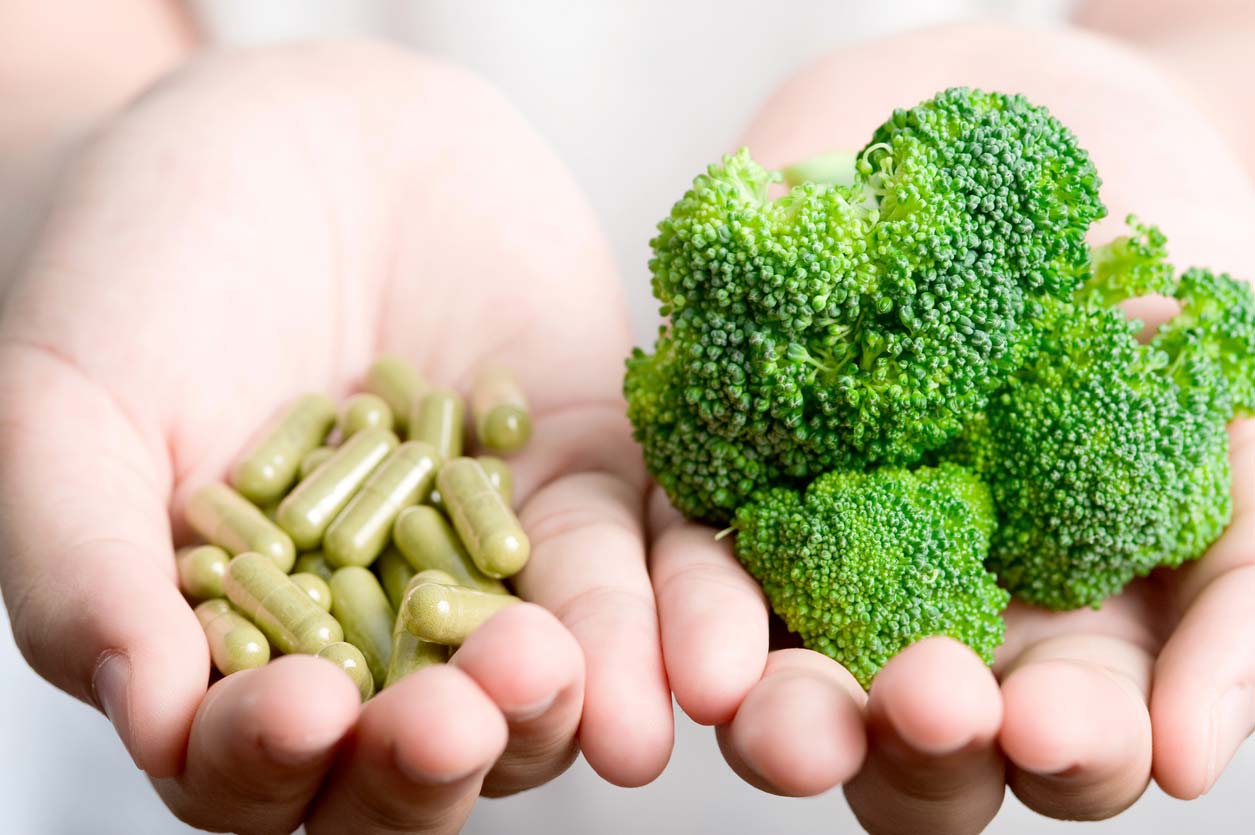
Most of the studies on sulforaphane use an extract or supplement rather than food sources. These are more concentrated forms and contain glucoraphanin (a glucosinolate), not sulforaphane. The thought behind this is that glucoraphanin will convert to sulforaphane in your stomach, as your gut bacteria contains a myrosinase-like enzyme that does the job. The problem is, without myrosinase being activated from cutting or chewing, you’re not getting the same level of sulforaphane as you would from eating a whole food (complete with a healthy supply of myrosinase on board). In fact, true broccoli sprouts outperform most supplements. So score one for getting sulforaphane from your diet if you can.
Editor’s Note:
If you’re looking for a convenient, research-backed way to get the benefits of sulforaphane, COMPLEMENT Sulfora is one of the most thoughtfully formulated options we’ve seen. Instead of attempting to stabilize sulforaphane (which is notoriously unstable), Sulfora provides glucoraphanin from broccoli seeds and myrosinase from mustard seeds, the two precursors your body needs to create fresh, active sulforaphane during digestion. This potent combination mimics what happens when you eat fresh broccoli or broccoli sprouts.
Each dose of Sulfora also includes complementary ingredients like kale extract, Brussels sprouts, camu camu, and quercetin for added antioxidant and immune support. It’s third-party tested for purity, packaged in a compostable pouch, and backed by a 100-day money-back guarantee. Click here to learn more and claim a special Food Revolution Network discount.
If you purchase through that link, COMPLEMENT will contribute a portion of the proceeds to support Food Revolution Network’s mission. (Thank you!)
How Much Sulforaphane Do You Need?
While sulforaphane has undeniable benefits for your health, there’s no established recommended daily amount of it to get just yet. Some studies use around 200 mg of dried broccoli sprouts, which is then often converted into extracts and supplements.
How much sulforaphane do you need?
½ cup per day of fresh broccoli sprouts is a great goal to aim for.
If you can handle the taste (some people find it zesty, others find it obnoxious), ½ cup per day of fresh broccoli sprouts is a great goal to aim for. Remember not to cook them, though, because eating them raw will keep more of the glucoraphanin and myrosinase intact. This recommendation applies to other cruciferous veggies too. It’s ideal to eat at least some of them raw if you want to reap the most benefits from their sulforaphane. Try to include one to two servings per day as part of a balanced diet.
If you can’t stomach raw broccoli, broccoli sprouts, or cauliflower, all is not lost. One study conducted by the University of Reading found that the addition of powdered mustard seeds to heat-processed broccoli (that’s how scientists say “cooked” when they’re trying to get published) significantly intensified the formation of sulforaphane.
How to Grow Your Own Broccoli Sprouts

Broccoli sprouts are easy to grow at home, and they provide an inexpensive way to help you incorporate sulforaphane (and many other potent nutrients) into your regular routine. Here’s how to do it.
- Soak three tablespoons of broccoli sprout seeds in cool water overnight, or for at least four hours.
- In the morning, drain the liquid from the seeds and rinse them well. Place your broccoli sprout seeds in a sprouter.
- Rinse and drain your seeds with cool water every 8-12 hours.
- On day three, move your sprouter into bright light. A good place might be near a kitchen window indoors. Here, you will continue to rinse and drain them every 8-12 hours.
- On days five through six, your sprouts will be ready to harvest. You can tell when their leaves are open and most of them are green.
- At harvest time, you can grab a big handful and throw them into a smoothie, toss them into a salad, juice them for a spicy “shot,” make one of the recipes below, or (for the adventurous type) eat them straight away.
- Make sure your sprouts are fairly dry before placing them in the fridge, as wet produce doesn’t store well and will not keep as long. You can roll them gently in a towel and let them sit for a period of time to dry before placing them in a container with a lid in the fridge.
Note: Broccoli sprouts are not for everyone. It is often recommended that children, pregnant women, the elderly, and people with compromised immune systems should avoid eating raw sprouts. All sprouts, whether purchased or homegrown, can run the risk of bacterial contamination, either from bacteria found on the seeds themselves or picked up during the sprouting process. To avoid contaminated seeds, get your seeds from a reputable business, such as SproutPeople or True Leaf Market, or you can treat the seeds on the stovetop in a solution of 3% hydrogen peroxide pre-heated to 140⁰ F. (For full instructions on how to sanitize your seeds, click here.)
For a more comprehensive look at how to grow all kinds of sprouts (and avoid food-borne illness), see this article.
3 Sulforaphane-Rich Recipes
It’s time to think outside the box if you’re struggling to get more than a daily dose of cruciferous vegetables into your diet. Peppery arugula and radish are the sulforaphane rock stars in the light and bright Lemony Arugula White Bean and Sunflower Salad. Brussels sprouts get dressed and shine on their own in the Tangy Tahini Brussels sprouts. And for anyone who has a challenge getting their kids (or partners) to chow down on the “stinky” veggies, make them these Cauliflower White Bean Burgers. Not only will they not know that the burgers are made with cauliflower, but they may even come back asking for more!
1. Lemony Arugula White Bean and Sunflower Salad
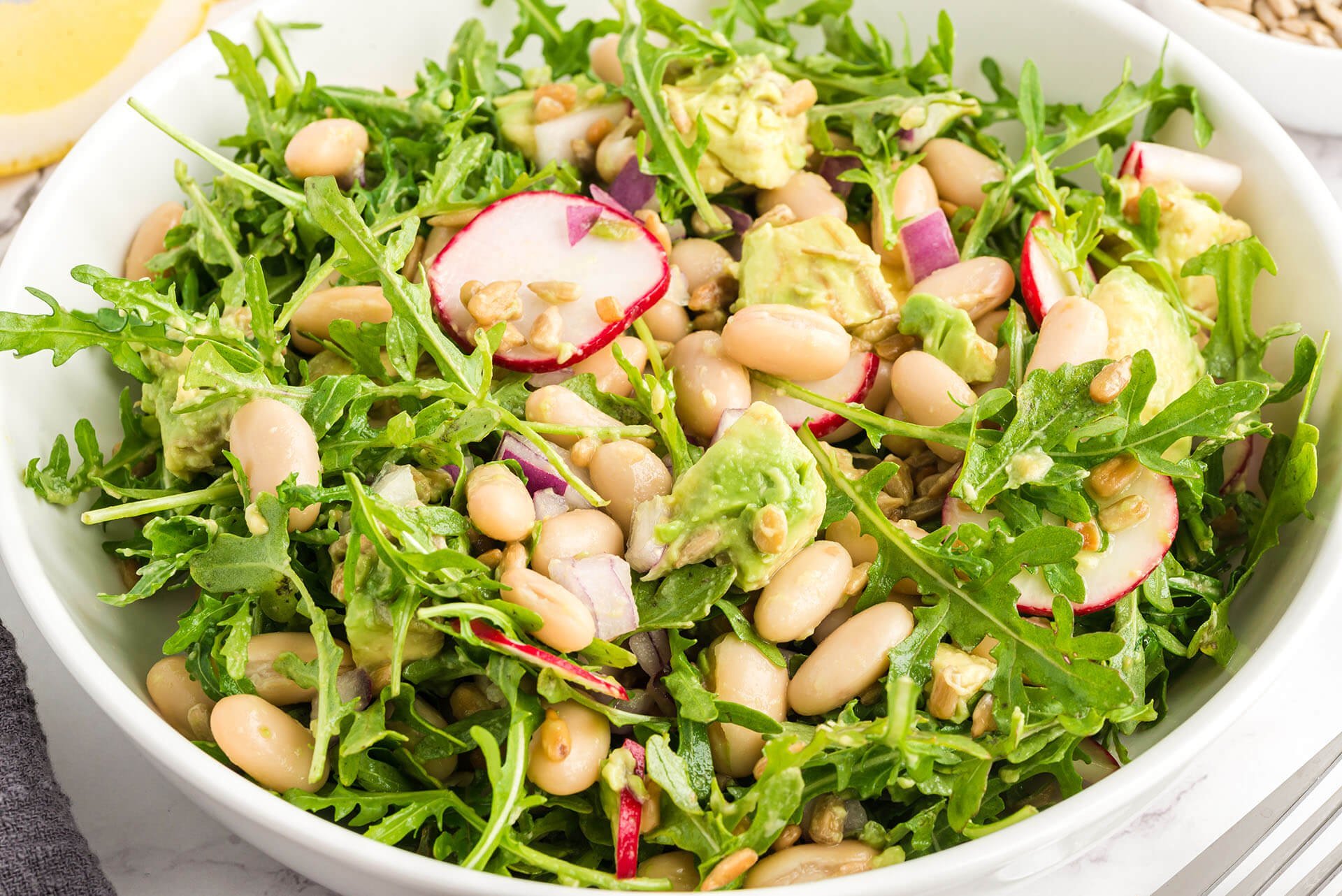
When you think of cruciferous veggies, you probably think of the stinky — but good for you! — veggies like broccoli, cauliflower, and Brussels sprouts. There are, however, some lesser-known cruciferous standouts too, like arugula (also known as “rocket”). Arugula makes a great addition to any sandwich. Or, if you love the peppery flavor, make it the focal point of a salad. Radish, which also adds a little peppery flavor, along with boatloads of nutrition, is another attention-worthy crucifer. Enjoy this salad as an appetizer, or double the portion and serve it as a plant-powered meal!
2. Tangy Tahini Brussels Sprouts
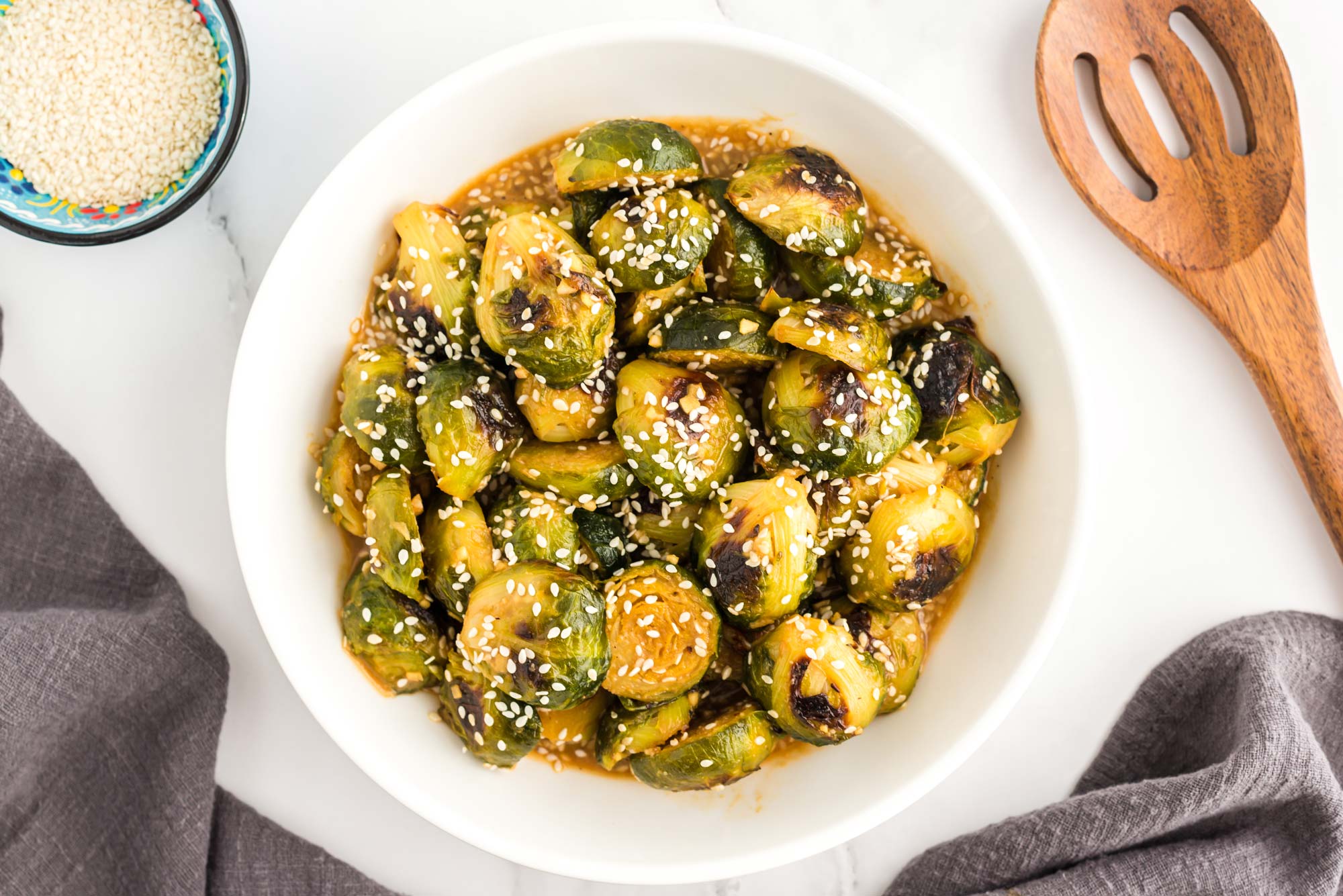
Here’s a fun activity: take a poll on your favorite social media channel and ask one question — ”Brussels sprouts, yes or no?” — and then watch the comments come pouring in. People are passionate about these beauties, whether it’s love or hate. Though we’re willing to bet that most will express their everlasting devotion and all the ways they enjoy cooking them. You might even get some new and inspiring culinary tips! For now, enjoy these wrapped in a tangy tahini sauce that can also be used in grain bowls and on top of salads.
3. Cauliflower White Bean Burgers

Do you know someone who refuses to eat their crucifers? Here’s a burger recipe that will please even the pickiest of palates. Cauliflower, beans, rice, and oats come together to make a veggie burger that is satisfying, nutritious, and unforgettable — in the best way! Double the batch and freeze half for later so you can hit your cauliflower quota throughout the month.
Sulforaphane as Part of a Healthy Diet
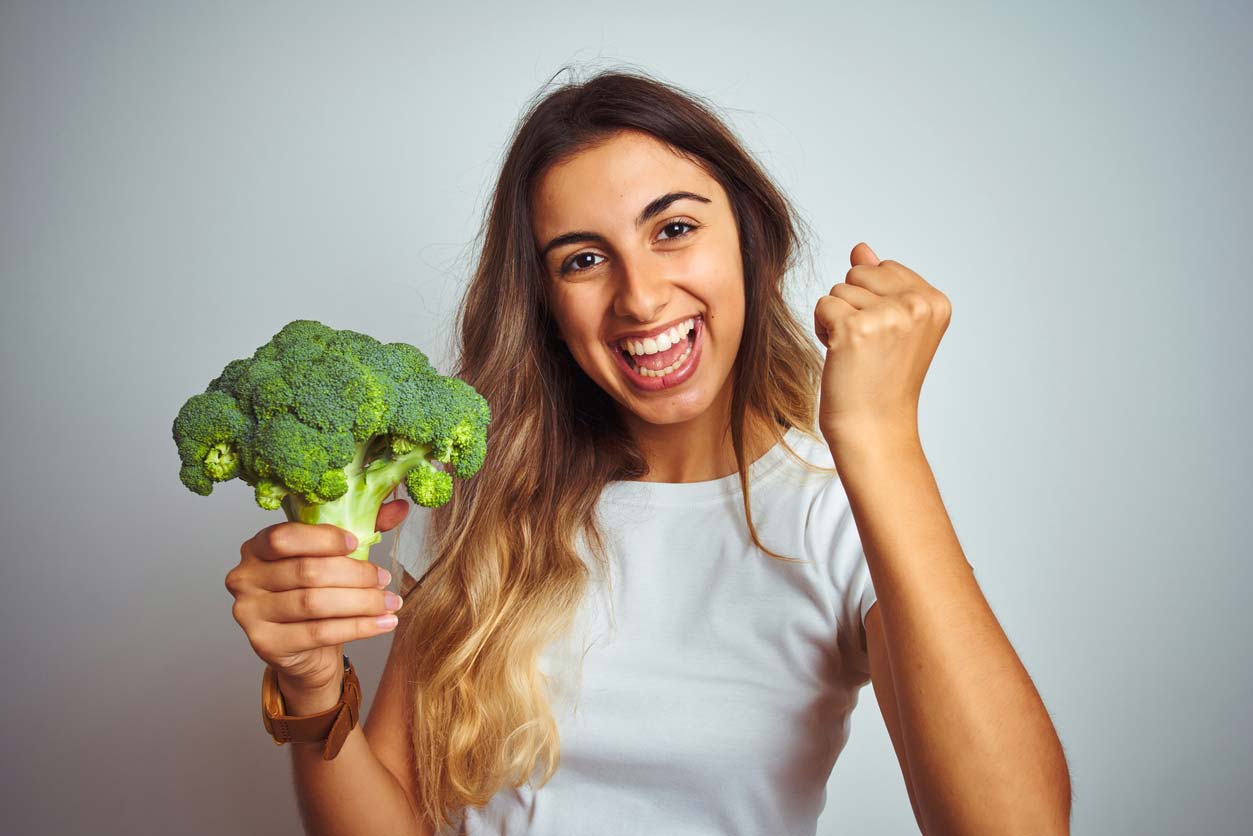
Sulforaphane is a powerful antioxidant with numerous benefits, including being anticancer, antimicrobial, and anti-inflammatory. Broccoli and broccoli sprouts contain the highest amounts of glucoraphanin, the precursor to sulforaphane, and eating them raw will give you the most benefit. But all of the cruciferous veggies bring health-boosting goodness. There are some supplements on the market that contain sulforaphane, and they may have benefits, too. But the most economical way to get it, as with most nutrients, is from your food. Incorporating broccoli and broccoli sprouts into a well-balanced, whole foods, plant-based diet will help to keep you on track to health.
Tell us in the comments:
- Do you eat broccoli sprouts? How do you like to prepare them, or do you enjoy them raw?
- Have you ever grown your own broccoli sprouts at home?
- What other sulforaphane-rich foods do you like to eat, or want to try?
Feature image: iStock.com/AaronAmat

